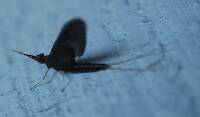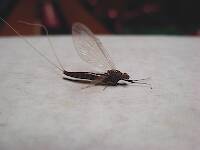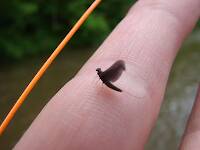
Salmonflies
Pteronarcys californica
The giant Salmonflies of the Western mountains are legendary for their proclivity to elicit consistent dry-fly action and ferocious strikes.
Featured on the forum

With a bit of help from the microscope, this specimen keys clearly and unsurprisingly to Hydropsyche.

Troutnut is a project started in 2003 by salmonid ecologist Jason "Troutnut" Neuswanger to help anglers and
fly tyers unabashedly embrace the entomological side of the sport. Learn more about Troutnut or
support the project for an enhanced experience here.
Troutnut on Apr 19, 2007April 19th, 2007, 4:13 am EDT
I think you're right. I couldn't say what species it is, but I don't see any reason not to presume I. bicolor.
I'm also not 100% positive it's a female, since the rear end is pretty blurry. Males in Isonychia have unusually small eyes.
I'm also not 100% positive it's a female, since the rear end is pretty blurry. Males in Isonychia have unusually small eyes.
Jason Neuswanger, Ph.D.
Troutnut and salmonid ecologist
Troutnut and salmonid ecologist
Quillgordon on Apr 19, 2007April 19th, 2007, 6:46 am EDT
Taxon,
Aren't the legs a big key here.
Front legs ..... brown
Mid/rear legs ....... cream (white)
* Charles Wetzel called the female spinner the 'White-gloved Howdy'.
Q.g.
Aren't the legs a big key here.
Front legs ..... brown
Mid/rear legs ....... cream (white)
* Charles Wetzel called the female spinner the 'White-gloved Howdy'.
Q.g.
Flyfishing is a state of mind! .............. Q.g.
C/R........barbless
C/R........barbless
GONZO on Apr 19, 2007April 19th, 2007, 7:20 am EDT
Roger-
This certainly looks like Isonychia to me. There are several Iso species with a southern distribution, so I won't hazard a guess about species.
John-
The leg colors you mention are pretty typical of Isonychia. Wetzel's "white-gloved howdy" name referred to the white-tipped front legs of the bicolor female, held out as if awaiting a greeting handshake. (I love that name!)
This certainly looks like Isonychia to me. There are several Iso species with a southern distribution, so I won't hazard a guess about species.
John-
The leg colors you mention are pretty typical of Isonychia. Wetzel's "white-gloved howdy" name referred to the white-tipped front legs of the bicolor female, held out as if awaiting a greeting handshake. (I love that name!)
Quillgordon on Apr 19, 2007April 19th, 2007, 7:55 am EDT
John-
The leg colors you mention are pretty typical of Isonychia. Wetzel's "white-gloved howdy" name referred to the white-tipped front legs of the bicolor female, held out as if awaiting a greeting handshake. (I love that name!)
* female spinner only....... @ 'Matching the Hatch', E. Schwiebert Jr. (pg.71).
Right....... These guys from PA. were pretty smart, weren't they. ..... LOL........
Flyfishing is a state of mind! .............. Q.g.
C/R........barbless
C/R........barbless
Taxon on Apr 19, 2007April 19th, 2007, 10:54 am EDT
Gonzo-
Right. There are actually (6) Isonychia species known to be in Alabama, and of those, only I. bicolor is described in flyfishing entomology literature.
Roger-
This certainly looks like Isonychia to me. There are several Iso species with a southern distribution, so I won't hazard a guess about species.
Right. There are actually (6) Isonychia species known to be in Alabama, and of those, only I. bicolor is described in flyfishing entomology literature.
Taxon on Apr 19, 2007April 19th, 2007, 11:11 am EDT
Jason-
Right. Aren't blurry rear ends just the pits! However, I believe the brownish blur is actually some basal cerci segments rather than claspers. Neither the fore legs nor eyes offered much help either. Actually, the character that caused me lean toward female, was the wing venation, which I believe to be more heavily stained in female than male Isonychia.
I'm also not 100% positive it's a female, since the rear end is pretty blurry. Males in Isonychia have unusually small eyes.
Right. Aren't blurry rear ends just the pits! However, I believe the brownish blur is actually some basal cerci segments rather than claspers. Neither the fore legs nor eyes offered much help either. Actually, the character that caused me lean toward female, was the wing venation, which I believe to be more heavily stained in female than male Isonychia.
Quick Reply
Related Discussions
Topic
Replies
Last Reply
0
Jul 3, 2006
by Troutnut
by Troutnut
13
Jul 25, 2014
by Millcreek
by Millcreek
5
Jun 14, 2008
by Wiflyfisher
by Wiflyfisher








